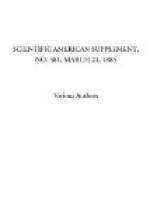In the region, b, of Fig. 6, the ligneous elements have undergone an evident change of form, and the walls have been broken. This region, already filled by petrifying salts, but not completely hardened, has not been able to resist, as the region, a, an external pressure, and has become more or less misshapened. As for the not yet mineralized external portion, c, it has completely given way under the pressure, the walls of the different organic elements have come into contact, the calcareous or other salts have been expressed, and this region exhibits the aspect of ordinary coal, while at the same time preserving a little more hardness on account of the small quantity of mineral salts that has remained in them despite the compression.
From the standpoint of carbonization there seems to us but little difference between the organic elements that occupy the region, a, and those that occupy b. If the former had not been filled with hardened petrifying matter, they would have been compressed and flattened like those of region c, and would have given a compact and brilliant coal, having very likely before petrifaction reached the same degree of carbonization as the latter. The layer of coal in contact with the carbonized or silicified part of the specimens is due, then, to a compression of the organic elements already chemically carbonized, but in which the mineral matter was not yet hardened and was able to escape.
[Illustration: 12g: FIG. 7.—Arthropitus gallica, St. Etienne; tangential longitudinal section.]
If this be so, we ought to find the remains of organic structure in this region c. In fact, on referring to Fig. 7, which represents a tangential, longitudinal section of the same specimen, we perceive at ab a ligneous duct and some unchanged tracheae situated in the carbonized region, and then at c the same elements, though flattened, in which, however, we still clearly distinguish the bands of the tracheae; at d is found a trachea whose contents were already solidified, and which has not been flattened; then, near the surface, in the region, e, the pressure having been greater, it is no longer possible to recognize traces of organization in a tangential section. In a large number of cases, the fact that the coal does not seem to be organized must be due to the too great compression that the carbonized cells and vessels have undergone when yet soft and elastic, at the time this slow but continuous pressure was being exerted.
It also became of interest to find out whether, through the very fact of carbonization, the dimensions of the organic elements had perceptibly varied—a sort of research that presents certain difficulties. At present we have no living plant that is comparable, even remotely, with those that grew during the coal epoch. Moreover, the organic elements have absolutely nothing constant in their dimensions.




